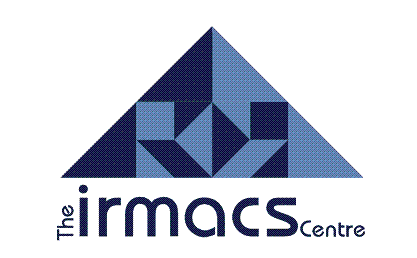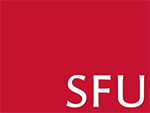2014 SFU Symposium on Mathematics and Computation
2014 Program
The 2014 SFU Symposium on Mathematics and Computation is a showcase of research in computational mathematics at SFU, UBC, and UVic.
Program Schedule
Date: Wednesday, August 6th, 2014
Location: The IRMACS Centre, Simon Fraser University
| Time | Event or Speaker | Title of Talk |
|---|---|---|
| 9:00am | Registration and Welcome Coffee |
|
| 9:30am | Ben Adcock (SFU) |
Getting more from less: compressed sensing and its applications |
|
10:15am |
Stephanie van Willigenburg (UBC) | |
| 11:00am | Morning Coffee and Poster Setup | |
| 11:15am | Poster Competition and Judging | |
| 12:15pm | Buffet Lunch |
|
| 1:15pm | Chris Sinclair (Oregon) | Mathematics in the computer age: exploration and exposition |
| 2:00pm | Greg Mori (SFU) |
Discriminative Latent Variable Models for Human Action Recognition |
| 2:45pm | Afternoon Coffee | |
| 3:00pm | Andrew King (D-Wave) | Working with the D-Wave quantum computer: Modeling, minors, and mitigation |
| 3:45pm | Award Ceremony | Awards for Putnam participants, Undergraduate Research Prize recipients, and Poster Prizes. |
| 4:15pm | Poster Presentations by Award Winners | |
| 4:30pm | Closing Remarks |
2014 Abstracts
Ben Adcock
Getting more from less: compressed sensing and its applications
Many problems in science and engineering require the reconstruction of an object - an image or signal, for example - from a collection of measurements. Due to time, cost or other constraints, one is often limited by the amount of data that can be collected. Compressed sensing is a mathematical theory and set of techniques that aim to enhance reconstruction quality from a given data set by exploiting the underlying structure of the unknown object; specifically, its sparsity. In this talk I will commence with an overview of some main aspects of standard compressed sensing. Next, motivated by some key applications, I will introduce several generalizations. First, I will show that compressed sensing is possible, and can in fact has some substantial benefits, under substantially relaxed conditions than those found in the standard setup. Second, time permitting, I will show that compressed sensing - whilst primarily a theory concerning finite-dimensional vectors - can also be extended to the infinite-dimensional setting, thus allowing accurate recovery of functions from small and incomplete data sets.
Andrew King
Working with the D-Wave quantum computer: Modeling, minors, and mitigation
The D-Wave Two (tm) is a quantum annealing processor consisting of 512 qubits operating at a temperature of 10-20 millikelvin. Its native operation finds a low-energy spin configuration in the Ising model on a fixed non-planar graph. In this talk I will give an overview of the system from a mathematician's perspective. Burning issues I will explore include quantumness, minor-embedding, error modeling, and upcoming developments.
Greg Mori
Discriminative Latent Variable Models for Human Action Recognition
Developing algorithms to interpret scenes of human activity involves a number of related tasks including human detection, tracking, and action recognition. These tasks are intertwined, information from one can provide assist in solving others. In this talk we will describe discriminative latent variable models to address these tasks together, focusing on the latent SVM / max-margin hidden conditional random field. We will review work a broad swath of work in this area. These methods can be used for jointly recognizing actions and spatio-temporally localizing them in videos. Models for human-human and human-object interactions will be presented. We will present methods for group activity recognition, with holistic analysis of entire scenes of people interacting and taking different social roles.
Chris Sinclair
Mathematics in the computer age: exploration and exposition
Mathematics is the study of provably true statements reachable using logic from an agreed upon set of assumptions. And, while the set of tools we use to prove statements has been largely static for the last few centuries, how we decide what to prove and how to share it with our students/colleagues/etc has undergone a remarkable transformation since the invention of the electronic computer. In this talk, I’ll demonstrate some phenomenon/patterns which are immediately apparent given a computer, and which without would probably have remained hidden from us. These examples give way to some very interesting (and applicable) mathematics, some of which I’ll try to explain. I’ll also talk a bit about how one might use new computer-based tools to share and explain new (or even old!) mathematics. So far, mathematicians have held on to linear modes of communication such as articles, books, etc, and while such things are unlikely to ever disappear, they don’t accurately reflect the true nature of mathematics as a body of knowledge (which is not a single linear progression of ideas, but a complicated highly connected graph), nor do they have the dynamic capacity to demonstrate the “doing" of mathematics. I wish to open a dialog about how modern computer-based tools can tackle the inherent non-linearity of mathematics in such a way as to open the beauty and applicability of mathematics to a wider section of humanity.
Stephanie van Willigenburg
Quasisymmetric refinements of Schur functions
Schur functions were introduced early in the last century with respect to representation theory, and since then have become important functions in other areas such as combinatorics and algebraic geometry. They have a beautiful combinatorial description in terms of diagrams, which allows many of their properties to be determined.
These symmetric functions form a subalgebra of the algebra of quasisymmetric functions, which date from the 1980s. Despite this connection, the existence of a natural quasisymmetric refinement of Schur functions has been considered unlikely.
However, in this talk we introduce quasisymmetric Schur functions, which refine Schur functions and many of their properties, as revealed by extensive computer-generated data.
This is joint work with Christine Bessenrodt, Jim Haglund, Kurt Luoto, Sarah Mason, Ed Richmond and Vasu Tewari.
The talk will require no prior knowledge of any of the above terms.
2014 Poster Session
Poster Information
The SFU Mathematics Department invites undergraduate and graduate research students to participate in the 2014 SFU Symposium on Mathematics and Computation Poster Competition. Postdocs and faculty may also present a poster but are not eligible for the competition.
The only requirement is that the poster has mathematics in it. It may be applied, pure, computational or experimental mathematics. If you have already prepared a poster for a presentation at another scientific meeting this year, and you would like to present it to members of the Department, this is an appropriate venue. If you wish to present a computer demo this is also possible.
Prizes
There will be one prize of $200 (winner) and one prize of $100 (runner-up) for the best undergraduate poster, and one prize of $200 (winner) and one prize of $100 (runner-up) for the best graduate poster. Judging will be based on both content and presentation.
Submission Details
Poster titles must be submitted via the online registration form by July 31st, 2014. Presenters are responsible for printing their own poster.
Display Details
The posters will be displayed in the IRMACS atrium. Poster presenters can set up their posters as early as 9:00am on August 6th, 2014. The poster and demo session will take place from 11:15am to 1:15pm. Awards will be made at 4:30pm, followed by a presentation of the winning undergraduate and winning graduate poster.
| Poster Title | Affiliation | Name |
|---|---|---|
| Complex Equiangular Lines from Hadamard Matrices | Simon Fraser University | Amy Wiebe |
| Enumerating Tucker Patterns in Binary Matrices to Reconstruct Ancestral Genomes | NSERC URSA, SFU Department of Mathematics | Jake Turner |
| Estimating fugitive emissions of lead using a Gaussian plume model | Phd student in the department of mathematics | Bamdad Hosseini |
| Identify Frequent User in Hospital Emergency Departments | SFU, Fraser Health | Laura(XinLu), Li |
| Identify Injection Drug User in Fraser Health Authority | SFU Mathematics | Zhihong(Jerry) Fang |
| Identifying Frequent Users in Hospital Emergency Departments | SFU, Fraser Health Authority | Hanna Kim |
| Identifying Frequent Users in Hospital Emergency Departments | SFU, Fraser Health Authority | Benny Ching Yin Wai |
| Integral Equation Methods for Point Vortex Motion on the Surface of the Sphere | Simon Fraser University | Natalia Iwanski |
| Leon's Probabilistic Algorithm for Minimum Distance of Linear Codes | Simon Fraser University, NSERC USRA | Paul Tran |
| Modelling and Evaluating Combinatorial Structures | Summer Student of Marni Mishna | Joshua Horacsek |
| Predicting Emergency Department Visits in Fraser Health | Simon Fraser University | Lief Pagalan |
| Predicting Emergency Department Visits in Fraser Health | Simon Fraser University | Mengyi Una Li |
| Predicting Emergency Department Visits in Fraser Health | Simon Fraser University | Eric Yuen |
| Predicting Emergency Department Visits in Fraser Health | Simon Fraser University | Brendan Bernardo |
| River Flow Computation Using Composite Numerical Integration | NSERC USRA, Dept of Mathematics, Simon Fraser University | Casie Bao |
| Singularly Perturbed Convection-Diffusion Problems | SFU Math Dept. | Nathan Sharp |
| The Natural Oscillation of Immersed Elastic Membranes: Theory and Experiment | CFD - John Stockie's Group | Darrell Tse |
| Use of the SMART Filter in a Data Assimilation Problem | Trinity Western University | David Grypma |
| Zero inertia approximations of biological aggregation differential equations | USRA Student | Darshan Crout |
2014 Registration
Details
- A registration fee of $30 per participant will be charged to all participants except invited speakers and invited guests. The registration fee includes the cost of a buffet lunch at IRMACS.
- Students may wish to ask their supervisor to pay for their registration fee.
- The registration fee may be paid by cash or cheque at the registration desk on the day of the event (receipt will be provided at registration) or through an SFU account (journal voucher).
- Participants who need assistance with the payment should contact Paul Tupper.
- If you are submitting a poster click on "Poster Submissions Details" to reveal the poster form.
- Personal demographic information is collected below to satisfy reporting requirements of funding agencies. Such information is anonymized before being sent to PIMS.

